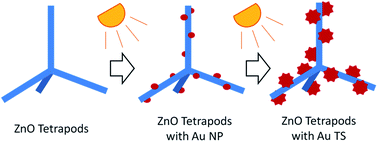Branched gold nanoparticles on ZnO 3D architecture as biomedical SERS sensors†
Abstract
Surface-enhanced Raman spectroscopy (SERS) widely improves the sensitivity of traditional Raman analysis, thus allowing this technique to be exploited for the development of new bio-analytical tests. In this work, 3D substrates made of zinc oxide tetrapods (ZnOTP) are decorated with branched gold nanoparticles by means of a new photochemical approach. The SERS enhancing properties of the obtained substrate are tested using different Raman dyes and apomorphine, a drug used for the management of Parkinson disease. The results prove that the enhancing properties depend on the shape of the gold nanoparticles grown on the branches of ZnO tetrapods. The optimized substrate here developed is characterized by an enhancing factor up to 7 × 106 and a detection limit for apomorphine of 1 μM. Finally, the new substrates are tested to study single cancer cells showing enhanced Raman signals related to the portion of the cell interacting with the 3D structure of the substrate.


 Please wait while we load your content...
Please wait while we load your content...